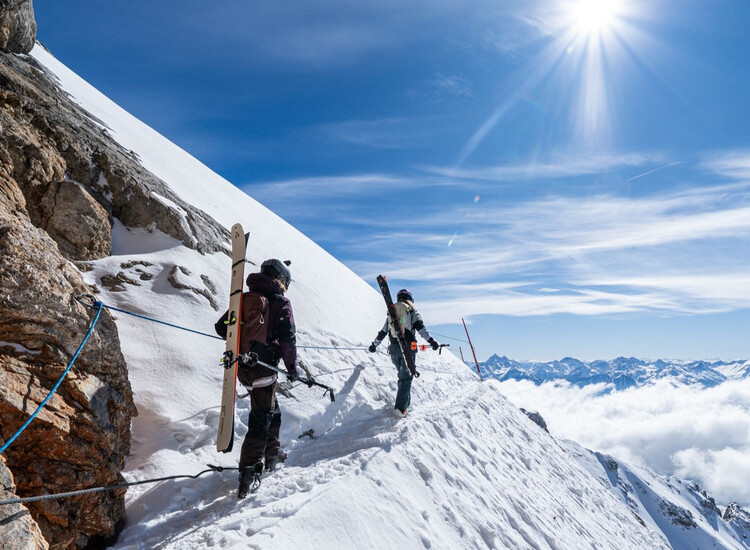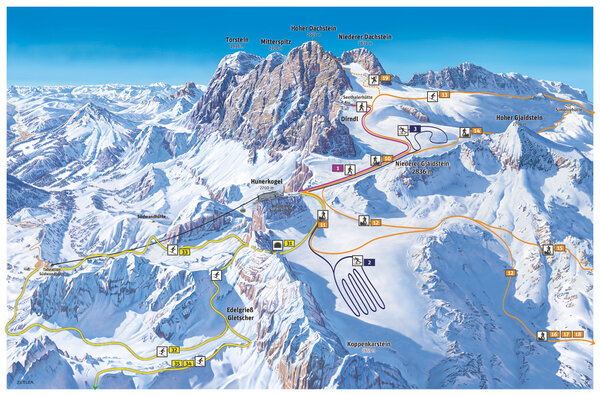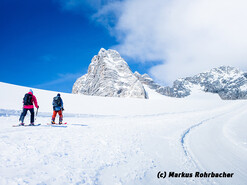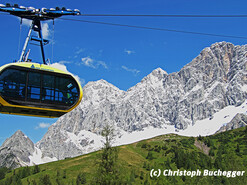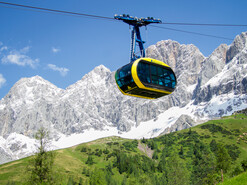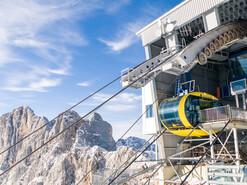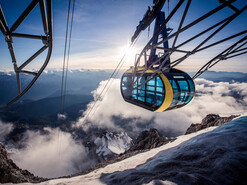Freeriding on the Dachstein
Feel freedom and experience adrenaline
Freeriding is the perfect combination of unspoilt nature and sporting adventure. The Dachstein offers you a variety of lines that will make every freerider's heart beat faster.
OFF-PISTE - IN THE MIDDLE OF ADVENTURE
The special feature for ski tourers – the Dachstein Glacier offers the opportunity to take your first ski tours as early as autumn. Thanks to its high altitude, the ski touring season here often begins as early as the end of September or October, while the valley below is still painted in the colors of autumn.
A NATURAL EXPERIENCE AND A SPORTING CHALLENGE
Whether wide powder slopes or challenging gullies - the Dachstein is the perfect starting point for anyone who wants to feel the freedom off-piste. Not only a unique natural experience awaits you here, but also the sporting challenge that makes freeriding so special. But away from the marked tours: safety first! Sound planning, the right equipment and up-to-date avalanche information are essential if you want to enjoy the descents to the full.
Ascent Dachstein glacier cable car
VALID FROM 24.05.2024 TO 06.04.2025 INCLUDING the toll for Dachstein Mautstrasse
| Adult | Youth | Child | |
|---|---|---|---|
|
Ascent |
€ 32,50 | € 24,50 | € 16,50 |
If you are in possession of a Ski Amadé ALL-IN Card gold or white, SuperSkiCard, Ski amadé day or multi-day ticket or the Steiermark Joker, the ascent on the Dachstein Glacier cable car is included.
IMPORTANT NOTE TOLL:
Please have your toll ticket validated at the machine in the Dachstein mountain station so that you can enjoy free use of the road.
31 Rosmariestollen
ROUTE DESCRIPTION
The Rosmariestollen is an artificially created tunnel linking the Schladming glacier with the Edelgrieß run. This 28-metre tunnel provides access to the Edelgrieß and Gruberscharte freeride routes, among other variants.
The tunnel is checked daily by the cable car operators and opened if conditions are suitable. Access to the north side is via a 30-metre ladder, and it is recommended to use a glacier harness and via ferrata set for safety. The glacier’s retreat over the years is visible in the ladder's length; 30 years ago, the entrance was just a few metres above the snow. The ladder’s bottom must now be extended regularly.
At the other end of the tunnel, you reach the exposed southern slopes of the Dachstein. Here begins the 150-metre crossing to the Edelgrieß run, marked and secured with a fixed cable. Use of a via ferrata set, crampons (depending on weather conditions), and attaching yourself to the cable is strongly recommended.
NOTE
You are in open skiing area in high alpine terrain. Ensure you are well informed about the weather and snow conditions and equipped with necessary safety gear.
Equipment
standard safety equipment (avalanche transceiver, shovel, probe, first aid), perhaps a harness and via ferrata set and crampons. Telephone, GPS app. Network coverage is sufficient.
32 Edelgrieß
One of the most famous freeride routes in the eastern Alps. Spectacular terrain, high alpine experiences and a descent of up to 1,400 metres without significant ascents. The Edelgrieß lies on the southern flanks of the Dachstein and is reached via the Rosmariestollen tunnel. Long deep snow or firn descents and several variants are possible depending on conditions. A correct assessment of the avalanche situation is required, along with good skiing technique.
ROUTE DESCRIPTION
Descent from the Dachstein mountain station to the Austriascharte col east of the Hunerkogel peak. A short ascent (with skis strapped to your rucksack) to the notorious 30-metre ladder to the Rosmariestollen tunnel. Secured with a harness and via ferrata set (the ascent can naturally be made free of equipment), you climb up the via ferrata to the tunnel entrance – the tunnel is opened and cleared of snow by the glacier cable car operators.
At the other end of the tunnel you stand directly on the exposed southern slopes of the Dachstein. The approximately 150-metre crossing to the Edelgrieß run is marked and secured with a cable – in corresponding conditions it is recommended that crampons are worn and a via ferrata set is used and to attach yourself to the cable.
At the end of the exposed crossing put on your skis, depending on the characteristics of the cornice either ski or abseil and cross the Edelgrieß glacier up towards the Edelgrießhöhe peak – choice of the line requires an assessment of the avalanche situation. From here the cirque turns slightly to the right and there will be either deep or firn snow, depending on the time of year.
Upon exiting the Edelgrieß you can either descend right towards the Türlwandhütte lodge to the valley station of the Dachstein gondola or keep left to the height of the Jungfrauensteig trail and descend a further 700 metres to Ramsau via the Kramllahn.
NOTE
Please note that you are in the open skiing area in high alpine terrain. Ensure you are well informed about the weather and snow conditions and that you have the necessary safety equipment.
Equipment
standard safety equipment (avalanche transceiver, shovel, probe, first aid), perhaps a harness and via ferrata set and crampons. Telephone, GPS app. Network coverage is sufficient.
33 Schwadrinn
The Schwadrinn descent is among the renowned and notorious steep descents that lead directly into the cirque beneath the Hunerkogel and the Dachstein gondola lift. The Schwadrinn is reached via the Rosmariestollen tunnel.
This descent requires exceptional skiing ability, alpine know-how, and comprehensive tour planning. The route is exceptionally difficult to follow, and its accessibility is heavily dependent on conditions.
We strongly advise that the services of a mountain and ski guide with local knowledge are employed.
Equipment
standard safety equipment (avalanche transceiver, shovel, probe, first aid), perhaps a harness and via ferrata set, crampons and a rope for the abseil point (depending on snow conditions). Telephone, GPS app. Network coverage is sufficient.
34 Gamsfeld
The Gamsfeld is among the large high alpine descents on the Dachstein and is reached either by ascending or via the Rosmariestollen tunnel and the Edelgrieshöhe peak. The entire route to Ramsau/Dachstein has an elevation gain of just over 1,400 metres.
This descent requires exceptional skiing ability, alpine know-how, and comprehensive tour planning. The route is exceptionally difficult to follow, and the accessibility of this variant is heavily dependent on conditions.
We strongly advise that the services of a mountain and ski guide with local knowledge are employed.
Equipment
standard safety equipment (avalanche transceiver, shovel, probe,first aid), perhaps a harness and via ferrata set, crampons and a rope for the abseil point (depending on conditions). Telephone, GPS app. Network coverage is sufficient.
35 Gruberscharte Freeride
One of the most beautiful freeride runs on the Dachstein for advanced skiers. Short ascents, high alpine terrain, a fabulous panorama, and an endless descent to Ramsau. The Gruberscharte is reached via the Rosmariestollen tunnel and the Edelgrießhöhe peak. There, the long descent begins through the Gruberkar cirque to the Gasthof Feisterer hotel. This route requires a high level of skiing ability and a good fitness level. It is only recommended in safe conditions when the weather is fine.
Route description
Descent from the Dachstein mountain station to the Austriascharte col east of the Hunerkogel peak. A short ascent (with skis strapped to your rucksack) to the notorious 30-metre ladder to the Rosmariestollen tunnel. Secured with a harness and via ferrata set (the ascent can naturally be made free of equipment), you climb up the via ferrata to the tunnel entrance – the tunnel is opened and cleared of snow by the glacier cable car operators.
At the other end of the tunnel, you stand directly on the exposed southern slopes of the Dachstein. The approximately 150-metre crossing to the Edelgrieß run is marked and secured with a cable – in corresponding conditions, it is recommended that crampons are worn and a via ferrata set is used to attach yourself to the cable.
At the end of the exposed crossing, put on your skis. Depending on the characteristics of the cornice, either ski or abseil and cross the Edelgrieß glacier up towards the Edelgrießhöhe peak.
Here, either with ski skins or your skis strapped to your rucksack, make the final short ascent to the Edelgrießhöhe. Keeping to the right under the Gamsfeld peak and past the Scheichen peak, cross to the entrance to the Landfriedtal valley. From here, bearing left, ski until you are beneath the Gruberscharte, strap your skis to your rucksack, and ascend the final 60 metres of elevation gain to the col.
Access to the massive Gruberkar cirque from the Gruberscharte col. Depending on conditions and the avalanche situation, bearing right as you descend, there is a series of sensational slopes until the forest cover slightly increases and the terrain ends at the Feisterer lift (also called the Schneemandl lift).
From the Feistererhof hotel (where food and drink are available), ski right across the undulating meadows to the state road to the bus station. The bus takes you back to Ramsau and to the valley station of the glacier cable car.
Notes
The route runs exclusively through the open ski area. Alpine knowledge is important in this terrain, and orientation is extremely difficult in fog. Expert avalanche assessment is necessary for the descent. Please ensure that you take note of the avalanche forecast and weather report.
Equipment
standard safety equipment (avalanche transceiver, shovel, probe, first aid), perhaps a harness and via ferrata set, crampons, short rope. Telephone, GPS app. Network coverage is sufficient.
36 Fluder
The Fluderrinne is the most demanding of the high-alpine descents on the Dachstein. It can be reached via the Rosmariestollen tunnel and Edelgrießhöhe peak. The route runs from the Gamsfeldspitze peak to Ramsau/the Dachstein, with an abseil point interrupting the descent at the end of the Fluderrinne.
Important Note
This descent requires exceptional skiing ability, alpine know-how, and comprehensive tour planning. The route is exceptionally difficult to follow, and the accessibility of this variant is heavily dependent on conditions.
We strongly advise that the services of a mountain and ski guide with local knowledge are employed.
Equipment
standard safety equipment (avalanche transceiver, shovel, probe, first aid), perhaps a harness and via ferrata set, crampons and a rope for the abseil point. Telephone, GPS app. Network coverage is sufficient.
Safety First
A modern avalanche transceiver, metal avalanche shovel, and a probe are among the basic items of equipment on any ski tour which takes place away from secured pistes and in the open ski area. This is because this triumvirate of transceiver/shovel and probe is important not only for being found quickly but above all to swiftly assist possible companions or other buried people.
A smartphone is also essential. It is recommended that you install a GPS app and familiarise yourself with its use. Network coverage is generally good on the Dachstein. A small first aid package with a multi-tool should also always be carried.
On some tours, it is recommended that a glacier harness and via ferrata set, crampons, pick, and a short rope are carried in order to be able to effectively react to the snow situation and conditions. You will find the exact equipment for the respective tours in the individual route descriptions.
The alpine emergency number is 140 in Austria (112 in Europe).
If you have no network reception, please restart your phone. Dial the emergency service before you enter the PIN code for your SIM card, as you can also make an emergency call on a third-party network.
Find out about the current avalanche situation before every tour at www.lawine-steiermark.at >>

